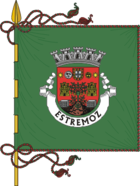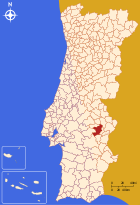Estremoz
| Estremoz | ||||||
|---|---|---|---|---|---|---|
|
||||||
| Basic data | ||||||
| Region : | Alentejo | |||||
| Sub-region : | Alentejo Central | |||||
| District : | Évora | |||||
| Concelho : | Estremoz | |||||
| Coordinates : | 38 ° 51 ′ N , 7 ° 35 ′ W | |||||
| Residents: | 14,318 (as of June 30, 2011) | |||||
| Surface: | 513.81 km² (as of January 1, 2010) | |||||
| Population density : | 28 inhabitants per km² | |||||
| Height: | 450 m | |||||
| Estremoz district | ||||||
|
||||||
| Residents: | 14,318 (as of June 30, 2011) | |||||
| Surface: | 513.81 km² (as of January 1, 2010) | |||||
| Population density : | 28 inhabitants per km² | |||||
| Number of municipalities : | 9 | |||||
| administration | ||||||
| Administration address: | Câmara Municipal de Estremoz Rossio Marquês de Pombal 7100-513 Estremoz |
|||||
| President of the Câmara Municipal: | Luís Filipe Pereira Mourinha, independent | |||||
| Website: | www.cm-estremoz.pt | |||||
Estremoz is a city in Portugal in the Évora district with just under 10,000 inhabitants. It is 450 meters above sea level.
The city is known for its marble and the local royal palace. In addition, Estremoz is listed twice by UNESCO as the home of intangible cultural heritage : the traditional craftsmanship of clay figurine production in Estremoz has been part of the Representative List of the Intangible Cultural Heritage of Humanity since 2017 ; Estremoz is also one of only seven districts ( concelhos ) in Portugal where Cowbells are made from the traditional craftsmanship of the Arte chocalheira , which has been on the list of intangible cultural heritage in urgent need of conservation since 2015 .
history
In the course of the Reconquista , the place was contested before it finally fell to Portugal under King D.Sancho II . Sancho II had the place re-fortified, and the fortifications were expanded during the tenure of the two subsequent kings. During the revolution in 1383 and the following war of independence, the population drove out the Spanish-friendly governor.
Estremoz was often the scene of armed conflicts in its further history. For example, during the War of the Spanish Succession in 1705 , the Count of Galveias gathered an army of 15,000 soldiers, 5,000 horses and 20 pieces of artillery here. In 1808 the French troops of General Kellermann conquered Estremoz during the Napoleonic invasions . The previous small town ( Vila ) Estremoz was elevated to a town ( Cidade ) in 1926 .
Attractions
The old town is dominated by the castle on the mountain, whose keep , Torre de Menagem and the royal palace, in which Rainha Santa Isabel died on July 4, 1336 , was under King Afonso III. Begun in 1258 . Since the construction of the tower took the reign of three kings to complete, it is also called the tower of the three crowns . An explosion in the powder arsenal in 1698 destroyed the castle. Only the Paço da Audiência , a star-shaped vaulted room known as King Dini's audience room, and the Gothic colonnades remained.
- From Rossio , to the right of the medieval stake , through the 14th century Arco da Frandina gate, a steep lane leads up to the castle.
- The Royal Palace, rebuilt in Gothic style by King João V in the 18th century , has now been transformed into one of the most famous Portuguese pousadas . The death room of Queen Isabella, venerated as a saint, was converted into a chapel in the 17th century , the Capela da Rainha Isabel , on whose azulejos scenes from the life of the queen are depicted. A modern marble monument in front of the Royal Palace commemorates them.
- In the castle there is a church with a square floor plan, the Ingreja de Santa Maria do Castelo , which was built in the 16th century and in which, in addition to some pictures by Portuguese masters of the late Middle Ages, a marble basin in the sacristy is worth seeing.
- The Paço da Audiência by Dom Dinis emerges from a medieval grain exchange that was redesigned in the 16th century by Manueline methods . Today there is a museum of modern design in this building.
- From the Rossio towards the lower town one arrives at the pelourinho , on which an armillary sphere , a medieval astronomical instrument rests.
- In the lower town, which is surrounded by a city wall, the Museu Municipal de Estremoz , the municipal folk art museum in the representative building opposite the keep, exhibits sacred art and nativity figures as well as the clay figures typical of Estremoz, the bonecos .
- The former palace of the Viceroy of India, which was converted into the Convento de Congregados in 1698 , is now the town hall.
- In the former Maltese monastery and later hospital with a two-storey Renaissance cloister, the harmoniously designed Ingreja de Misericórdia is also noteworthy because of a nativity scene by Machado de Castro .
- North of the Rossio is the 17th century Tocha Palace , where azulejos can be seen.
- Next to it is the São Francisco Convent from the time of King Afonso III. from the 13th century , which served as barracks after the secularization, in which, in addition to sarcophagi and a root Jesse altar, the magnificent tomb Vasco Esteves Gato, donor of a chapel in the 15th century, demands all attention. The high altar from 1623 is adorned with precious azulejos.
- At the Fonte da Gadanha square, a fountain with a statue of Saturn is worth seeing.
- On the outskirts of the village is the Museu da Alfaia Agricola , the museum for agricultural equipment, a former flour mill that has been lovingly and diligently furnished, in which old tools and accessories from the rural area are shown.
- The old water reservoir Tanque dos Mouros is located on the southern outskirts.
Marble quarries
In the triangle Estremoz - Borba - Vila Viçosa , a finely crystalline, homogeneous marble is extracted in over 100 quarries , the color spectrum of which ranges from white cream to creamy rose to intense pink. Estremoz marble is used in high-quality interior design such as wall and floor coverings, stairs, washbasins, columns and fireplace surrounds.
administration
circle
Estremoz is the administrative seat of a district of the same name ( concelho ) in the Évora district . On June 30, 2011, the district had 14,318 inhabitants on an area of 513.8 km².
The neighboring districts are (starting clockwise in the north): Sousel , Fronteira , Monforte , Borba , Redondo , Évora and Arraiolos .
With the regional reform in September 2013, several municipalities were merged into new municipalities, so that the number of municipalities decreased from 13 to nine.
The following municipalities ( Freguesias ) are in the Estremoz district:
| local community | Population (2011) |
Area km² |
Density of population / km² |
LAU code |
|---|---|---|---|---|
| Ameixial (Santa Vitória e São Bento) | 697 | 97.49 | 7th | 070417 |
| Arcos | 1,152 | 23.89 | 48 | 070401 |
| Estremoz (Santa Maria e Santo André) | 8,662 | 63.90 | 136 | 070414 |
| Évora Monte | 569 | 99.39 | 6th | 070404 |
| Glória | 532 | 72.75 | 7th | 070402 |
| São Bento do Cortiço e Santo Estêvão | 773 | 56.97 | 14th | 070415 |
| São Domingos de Ana Loura | 341 | 16.30 | 21st | 070411 |
| São Lourenço de Mamporcão e São Bento de Ana Loura | 556 | 43.40 | 13 | 070416 |
| Veiros | 1,036 | 39.72 | 26th | 070413 |
| Estremoz district | 14,318 | 513.81 | 28 | 0704 |
Population development
| Population in the Estremoz district (1801–2011) | |||||||||
|---|---|---|---|---|---|---|---|---|---|
| 1801 | 1849 | 1900 | 1930 | 1960 | 1981 | 1991 | 2001 | 2011 | |
| 10,722 | 8,504 | 16,238 | 20,550 | 23,201 | 18,073 | 15,461 | 15,672 | 14,328 | |
Town twinning
sons and daughters of the town
- Alfons of Braganza (1377–1461), illegitimate son of King John I
- Francisco de Melo (1597–1651), military and ambassador, governor of the Habsburg Netherlands
- Francisco de Melo e Castro (1702–1765 / 1777), colonial administrator
- José António Freire de Andrade (1708–1784), aristocratic military man, governor of Minas Gerais in Brazil
- João Mendes Sachetti Barbosa (1714–1774), doctor and researcher
- João de Sousa Carvalho (1745–1799), composer
- Alfredo Cortês (1880–1946), playwright and lawyer
- Tomás Alcaide (1901–1967), opera tenor
- António de Spínola (1910–1996), general and conservative politician, first president after the Carnation Revolution
- João Luís Graça Zagallo Vieira da Silva (1916–1979), veterinarian and politician
- Sabina Santos (1921–2005), ceramic artist
- Joaquim José Vermelho (1927–2002), poet and journalist
- Rogério Ribeiro (1930–2008), painter, illustrator and azulejos artist
- Maria Luísa da Conceição (* 1934), ceramic artist
- Armando Alves (* 1935), painter and graphic artist
- Mário Tomé (* 1940), officer and politician of the Bloco de Esquerda , member of the MFA in the Carnation Revolution
- Joaquim Murale (* 1953), playwright, poet and novelist
- Carmen Balesteros (1961–2013), archaeologist, historian and politician
- Célia Freitas (* 1966), artisan, clay artist
- Paulo Sérgio Bento Brito (* 1968), football player and coach
Web links
- Official website of the Estremoz City Council
Individual evidence
- ↑ a b c www.ine.pt - indicator resident population by place of residence and sex; Decennial in the database of the Instituto Nacional de Estatística
- ↑ a b Overview of code assignments from Freguesias on epp.eurostat.ec.europa.eu
- ↑ http://www.rr.pt/informacao_detalhe.aspx?fid=1167&did=74428
- ↑ Entry of the Estremoz tomper doll production at UNESCO, accessed on January 13, 2020
- ↑ www.monumentos.pt (under Cronologia ), accessed on November 15, 2013
- ↑ Route “In the Colors of Marble” , visitalentejo.pt, accessed May 5, 2014
- ^ Publication of the administrative reorganization in the Diário da República gazette of January 28, 2013, accessed on March 16, 2014
- ↑ www.anmp.pt , accessed on February 2, 2013










